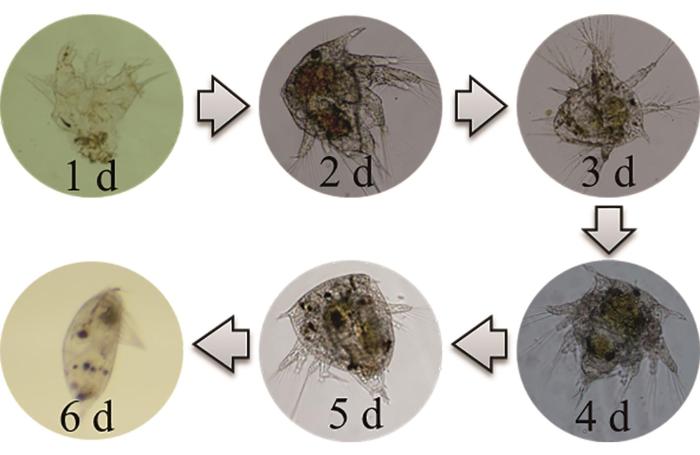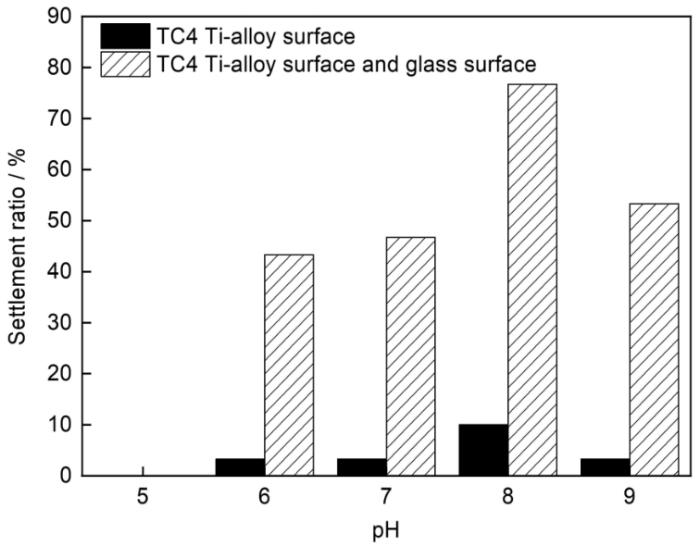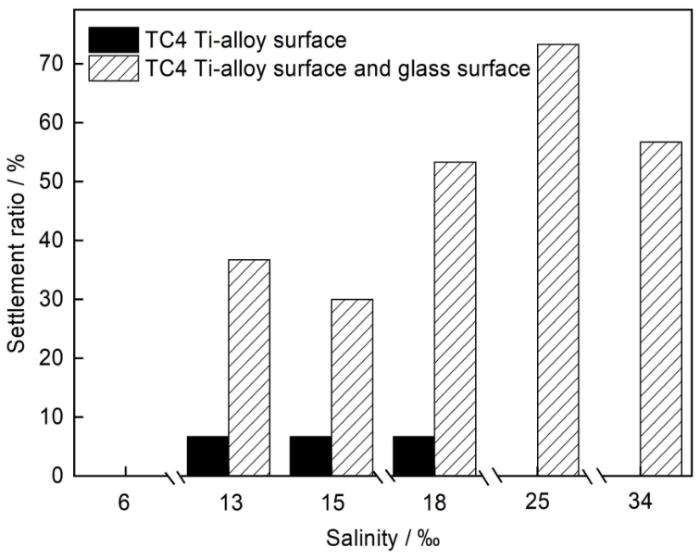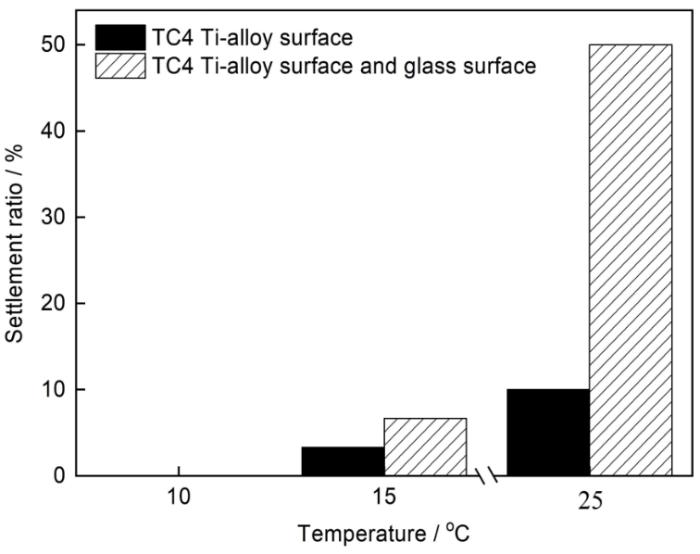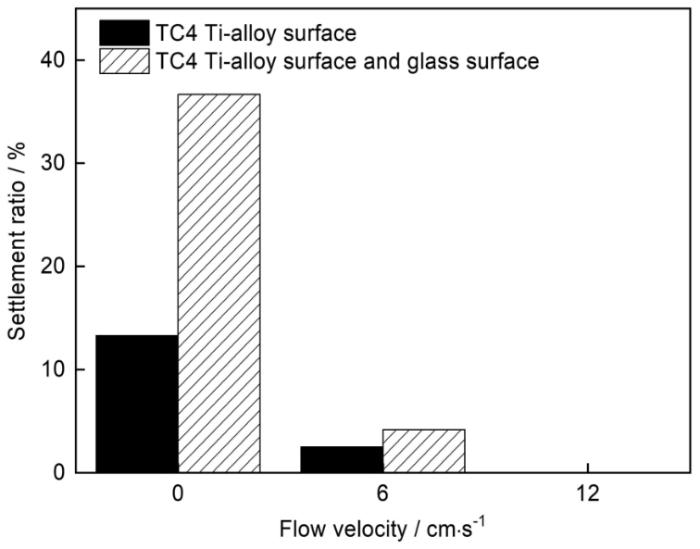海洋设施如轮船、管道、漂浮装置、石油钻井平台等表面与海水接触,会被细菌、真菌、藻类和宏观生物附着产生生物污损,这不仅增加海洋设施的负重,降低船速,增加能耗,还会影响外观,导致材料的腐蚀破坏。藤壶是海洋生态系统中最丰富的大型污损生物之一,是一种常见的节肢动物,广泛地分布在潮间带的生物群落中[1],一般附着在永久淹没或定期湿润的物体表面。成年钙化的藤壶与附着基底表面可通过二硫键交联的疏水蛋白复合体进行紧密结合[2,3]。藤壶附着在像港口、运输管道和船舶底部等海洋设施上会降低设备使用寿命,对各国的沿海地区造成巨大的经济损失[4]。藤壶幼虫的生命周期涉及到六个浮游的无节幼虫阶段以及一个不需要进食的金星幼虫阶段[5]。藤壶的金星幼虫体长大约0.5 mm,通过身体前部的一对触角在基底表面探索时分泌黏合剂[6]。这种黏合剂在水中不分散、抗生物降解且具有信号分子的功能,会吸引更多的金星幼虫在附近进行附着[7]。藤壶是典型的宏观污损生物,它们附着速度快、强度高,难以清理,是宏观生物污损研究的模式生物,其死亡腐烂后产生的酸和释放出的酶可以快速分解涂料,并腐蚀下方金属。
目前,研究主要从内在和外在因素对藤壶的附着变态机制进行了研究[8~10]。内在因素包括藤壶金星幼虫自身生理状态、水溶性信息素、足迹蛋白、激素和生物膜等[11~15]。而外在因素包括基底条件和环境因素,基底条件主要涉及表面能和化学涂层,而环境因素则涉及到海水盐度、初始pH、温度、营养物质、水流速和光照强度等因素[16,17]。Larsson和Jonsson[18]的研究显示,致密藤壶(Balanus improvises)金星幼虫会尽量避免在流速超过5~10 cm/s海水中的表面附着。在北大西洋进行的研究中,Want等[19]研究表明在最大海水流速0.4~4.0 m/s的范围内,巨大藤壶Chirona hameri能够在水泥、高密度聚乙烯和钢材等广泛的人造基质表面附着。专性附着鲸类的异鲸藤壶(Xenobalanus globicipitis)不出现在低温海水鲸类的体表,但出现在迁徙鲸类的体表,因此异鲸藤壶的附着很可能发生在温暖水域[20]。遮光实验显示Semibalanus cariosus在遮光处基底上的附着率更高,并且基底的温度更低[21]。β回归分析表明,藤壶在牡蛎壳上的附着受到了pH、盐度、挂样海域位置和海水浑浊度的影响[22]。迄今,环境因素对藤壶附着影响的研究主要是在实海环境下进行的,然而实海环境因素的变化基本上是多因素同时变化,极少有单一因素的变化,这些变化可控性差,很难据其准确分析环境因素对藤壶附着的影响。目前,环境因素对于藤壶金星幼虫在生物相容性极佳的钛合金表面附着的影响仍不清楚。此外,由于钛合金的强度高,重量轻及耐腐蚀性能优异,其越来越多地被用于海上油气平台、海水冷凝器等海洋设施[23~25],但钛合金的生物污损尤其是藤壶造成的污损却极大地降低了钛合金的性能,因此,在可控条件下探索藤壶在钛合金表面附着的环境影响因素十分必要,这对钛合金在海洋中的使用和污损防治均有重要作用。
1 实验方法
1.1 藤壶的采集与培养
网纹藤壶的成熟个体采集于海南省海口市潮间带,采集时选择表面网纹藤壶附着较多、个体较大的石块。将采集的成熟个体使用干净的海水进行清洗,清洗后的样品一部分用于取藤壶幼虫,一部分在室温下干净海水中进行培养。藤壶成熟个体的培养需要在海水中进行曝气,并每天使用新鲜的扁藻进行喂养,每隔2~3 d左右换一次海水[26]。
将网纹藤壶附着较多的石块置于黑暗条件下阴干12 h左右,然后放入盛有700 mL过滤消毒海水的1 L烧杯中,大约半小时后会孵化出I期无节幼虫,在烧杯外壁部位使用点光源照射,幼虫由于具有趋光习性向点光源处聚集,使用1 mL移液枪收集。
取浓度约3 × 105 cells/mL的扁藻150 mL置于500 mL的烧杯中,并添加150 mL消毒过滤后的海水,用移液枪收集无节幼虫置于烧杯中,保证幼虫的密度在1~2 ind/mL。将收集的无节幼虫于26℃的恒温培养箱中在黑暗条件下进行培养,并每天早晚期间各取出一次于自然光下放置30 min,期间视情况进行曝气和添加少量扁藻饵料。培养5~7 d左右,大部分无节幼虫变态为金星幼虫。显微镜下观察幼虫发育情况如图1。
图1
图1
孵化后不同时间的网纹藤壶无节幼虫到金星幼虫的发育及变态情况
Fig.1
Development and metamorphosis of Balanus reticulatus nauplii into Balanus reticulatus cyprids after release from brood for 1, 2, 3, 4, 5 and 6 d
1.2 实验材料
TC4钛合金 (Ti-6Al-4V) 试样的尺寸为30 mm ×30 mm × 2.5 mm,用180#和800#砂纸依次打磨至表面没有明显缺陷。通过超声震荡,用丙酮将试样表面的油污去除,接着在超声震荡下,用蒸馏水和乙醇依次清洗试样以去除沙粒和污垢;然后将试样在无菌条件下晾干。最后,将所有的试样保存在干燥器中备用。
1.3 海水配置及实验过程
实验前将5份80 mL过滤灭菌的海水分别放置于5个内径为Φ52 mm的100 mL玻璃烧杯中,用0.5 mol/L的HCl和1 mol/L的NaOH将5份海水中的pH依次调节至5、6、7、8和9。将5片试样分别放入已调节好的不同pH的海水中,平铺于烧杯底部,海水在烧杯内的高度为39 mm。每种pH的海水中加入刚变态完成的金星幼虫30只,观察金星幼虫在钛合金表面和玻璃烧杯内表面的附着情况。以上实验重复3次。
实验前取80 mL灭菌后的蒸馏水6份,分别放置于6个内径为Φ52 mm的100 mL玻璃烧杯中,分别向其中添加海盐,用玻璃棒充分搅拌溶解,用ATC折光式海水盐度计测定盐度值,获得盐度分别为34‰、25‰、18‰、15‰、13‰和6‰的盐溶液。将6片试样分别放入已配置好的不同盐度的6份盐溶液中,平铺于烧杯底部,海水在烧杯内的高度为39 mm。每种不同盐度的盐溶液中加入刚变态完成的金星幼虫30只,观察金星幼虫在钛合金表面和玻璃烧杯内表面的附着情况。以上实验重复3次。
实验前取3份80 mL的过滤灭菌海水,分别放入3个内径为Φ52 mm的100 mL玻璃烧杯中,将3片试样分别放入这3份过滤灭菌海水中,平铺于烧杯底部,海水在烧杯内的高度为39 mm。将3个烧杯分别放入10、15和25℃的培养箱中,当烧杯中的海水温度达到设定温度并稳定后,在每个烧杯的海水中加入30只刚变态完成的金星幼虫,观察金星幼虫在钛合金表面和玻璃烧杯内表面的附着情况。以上实验重复3次。
实验前取3份320 mL的过滤灭菌海水,分别放置于3个内部尺寸为200 mm × 40 mm × 60 mm的玻璃槽中,每个玻璃槽底部(200 mm × 40 mm)平铺4片试样,海水在槽内的高度为41 mm。玻璃槽的一端有出水口,另一端有入水口,且处于关闭状态,出水口和入水口有滤网以防金星幼虫脱离水槽。第1个槽的出水口和入水口始终关闭,将第2个槽的出水口和入水口通过管道分别与一台水泵的入水口和出水口相连,第3个槽用同样的方法与另一台水泵相连,将第2和第3个槽的出水口和入水口打开,启动水泵低速运转,在第2和第3个槽中添加适量的过滤灭菌海水,使得灭菌海水充满管道和水泵之后,两个槽中仍分别有320 mL的灭菌海水。在每个槽中加入120只刚变态成功的金星幼虫,第1个槽中的海水流速为0 cm/s,调节水泵的转速使得第2和第3个槽中海水流速分别为6和12 cm/s,观察金星幼虫在钛合金表面和玻璃槽内表面的附着情况。以上实验重复3次。
金星幼虫在钛合金表面附着率
式中,NT为钛合金表面藤壶成体数量,NC为初始加入的金星幼虫总数。
式中,NTG为钛合金表面和玻璃表面的藤壶成体数量之和。
2 结果与讨论
2.1 不同pH下网纹藤壶金星幼虫附着率
图2为不同pH条件下的海水中网纹藤壶金星幼虫在钛合金表面附着率以及整体附着率。在TC4钛合金表面,海水pH为5时的附着率为0%,pH为6、7、8和9时的附着率分别为3.3%,3.3%,10%和3.3%。对于整体附着率,pH为5时,整体附着率为0%,pH为6、7、8和9时,整体附着率分别为43.3%,46.7%,76.7%和53.3%。钛合金表面附着率和整体附着率在pH为8时都达到最大值。pH为5的情况下,金星幼虫存活困难,因此不附着。
图2
图2
不同pH下网纹藤壶金星幼虫在TC4钛合金表面的附着率及在TC4钛合金表面和玻璃表面的整体附着率
Fig.2
Effects of pH on settlement ratios of Balanus reticulatus cyprids on only TC4 Ti-alloy and both TC4 Ti-alloy and glass
2.2 不同盐度下网纹藤壶金星幼虫的附着率
图3是不同盐度的盐溶液中网纹藤壶金星幼虫在钛合金表面附着率以及整体附着率。对于TC4钛合金表面,在盐度较低和较高的6‰、25‰和34‰下,金星幼虫的附着率均是0%,而在盐度13‰、15‰和18 ‰的盐溶液中,金星幼虫的附着率都是6.67%,达到最大值,因此,网纹藤壶金星幼虫在TC4钛合金表面附着最适宜的盐度在13‰~18‰之间。盐溶液中,在盐度6‰下,金星幼虫的整体附着率是0%,在13‰、15‰、18‰、25‰和34‰下,整体附着率是36.7%,30%,53.3%,73.3%和56.7%。网纹藤壶在玻璃上的附着率在盐度为25 ‰时达到最大值,这和在钛合金表面的附着有显著区别。
图3
图3
不同盐度下网纹藤壶金星幼虫在TC4钛合金表面的附着率及在TC4钛合金表面和玻璃表面的整体附着率
Fig.3
Effects of salinity on settlement ratios of Balanus reticulatus cyprids on only TC4 Ti-alloy and both TC4 Titanium alloy and glass
2.3 不同温度下网纹藤壶金星幼虫的附着率
图4是不同温度的海水中网纹藤壶金星幼虫在钛合金表面附着率以及整体附着率。当温度为10℃,金星幼虫在TC4钛合金表面的附着率为0%,而当温度为15和25℃,金星幼虫在TC4钛合金表面的附着率分别为3.3%和10%。在10℃下,金星幼虫的整体附着率为0%,而在15和25℃下,金星幼虫的整体附着率分别为6.67%和50%。
图4
图4
不同温度下网纹藤壶金星幼虫在TC4钛合金表面的附着率及在TC4钛合金表面和玻璃表面的整体附着率
Fig.4
Effects of temperature on settlement ratios of Balanus reticulatus cyprids on only TC4 Ti-alloy and both TC4 Ti-alloy and glass
2.4 不同海水流速下网纹藤壶金星幼虫的附着率
图5为不同海水流速下网纹藤壶金星幼虫在钛合金表面附着率和整体附着率。在TC4钛合金表面,当海水流速为12 cm/s,金星幼虫的附着率为0%,而当海水流速为0与6 cm/s,金星幼虫的附着率分别为13.3%和2.5%。当海水流速为12 cm/s,金星幼虫的整体附着率为0%,当海水流速为0和6 cm/s,金星幼虫的整体附着率分别为36.67%和4.17%。
图5
图5
不同海水流速下网纹藤壶金星幼虫在TC4钛合金表面的附着率及在TC4钛合金表面和玻璃表面的整体附着率
Fig.5
Effects of seawater flow velocity on settlement ratios of Balanus reticulatus cyprids on only TC4 Ti-alloy and both TC4 Ti-alloy and glass
2.5 讨论
由上述结果可以看出环境因素对网纹藤壶金星幼虫的附着有显著影响。在酸性环境下,当海水的pH为5时,网纹藤壶金星幼虫很快失去活性不再游动,因此金星幼虫在钛合金表面的附着率和整体附着率均为0%[27]。当材料表面被产酸微生物附着,其在表面产生的pH一般小于5,这将对藤壶附着有一定的抑制作用。在TC4钛合金表面pH为8(偏碱性)的情况下,金星幼虫在TC4钛合金表面附着率最高,而自然海水pH即约为8,如表1所示(资料来源于国家材料腐蚀与防护科学数据中心,因此自然海水pH条件下金星幼虫在TC4钛合金表面的附着率最高。网纹藤壶金星幼虫在玻璃表面的附着率也是在自然海水的pH下最高(玻璃表面的附着率可以从整体附着率-钛合金表面附着率得出)。在pH为5、6、7、8和9的海水中,网纹藤壶金星幼虫在玻璃表面的附着率和整体附着率由高到低的顺序为pH8 > pH9 > pH7 > pH6 > pH5,网纹藤壶金星幼虫在钛合金表面的附着率由高到低的顺序为pH8 > pH9 = pH7 = pH6 > pH5,偏酸性比偏碱性更易降低网纹藤壶金星幼虫的附着,因此降低藤壶附着率可以考虑从降低环境pH入手,如采取微胶囊法提高材料表面酸性,或采取产酸生物膜均有可能控制藤壶污损。网纹藤壶金星幼虫在pH为9碱性较强情况下仍然有较高的附着率,但其附着率也低于pH为8时的附着率。在海洋中进行土木建设的设施周围会出现附着藤壶减少的现象,有可能是藤壶金星幼虫在pH大于8的情况下附着率下降,因而自然死亡的藤壶成体数量大于附着的藤壶金星幼虫数量导致的。
表1 青岛、厦门和三亚海域的海水理化参数
Table 1
| Sea area | Seawater temperature oC | Total salt content ‰ | Dissolved oxygen mg·L-1 | Chemical oxygen demand mg·L-1 | pH | Air temperature oC |
|---|---|---|---|---|---|---|
| Qingdao | 14.09 | 32.40 | 7.58 | 7.62 | 8.18 | 12.22 |
| Xiamen | 21.83 | 27.18 | 5.95 | 7.72 | 8.03 | 20.7 |
| Sanya | 26.38 | 32.31 | 6.44 | 8.10 | 8.12 | 25.63 |
由表1可以看出,自然海水盐度在30‰左右。 当盐溶液盐度为6‰时,网纹藤壶金星幼虫失去活性,在钛合金表面附着率和整体附着率均为0%,低盐度盐溶液与幼虫体内存在渗透压差,导致网纹藤壶金星幼虫在低盐度(≤6‰)下很难生存[16]。在TC4钛合金表面,网纹藤壶金星幼虫在盐度较高为25‰和34‰的盐溶液中也未见附着,这与实际情况(自然海洋中钛合金表面藤壶污损严重)有一定差异,盐溶液和自然海水成分的差异尤其是其中有机物的差异可能是原因之一。在只改变盐度单因素条件下,TC4钛合金表面在盐度在13‰~18‰之间易于网纹藤壶金星幼虫的附着。金星幼虫整体附着率在盐度为13‰、15‰、18‰、25‰和34‰的盐溶液中由高到低的顺序为25‰ > 34‰ > 18‰ > 13‰ > 15‰,在25‰和34‰下均较高,在盐度为25‰时达最大值73.3%,该盐度也明显低于自然海水盐度,因此网纹藤壶金星幼虫是在盐度偏低情况下更易于附着。在实际考察中发现河流入海口附近船只污损速度快,而且污损程度更为严重,这可能就是由于入海口附近盐度偏低导致,与本实验研究结果一致。当盐度低于18‰时,网纹藤壶金星幼虫的整体附着率明显降低,低盐度作为环境胁迫因子使网纹藤壶金星幼虫过多消耗为黏附所储存的能量,从而降低附着率[28]。当盐度大于等于25‰,网纹藤壶金星幼虫只附着在玻璃表面,并且呈现聚集性附着。
海水温度为10℃时,网纹藤壶金星幼虫仍然会游动,然而在钛合金表面附着率和整体附着率都是0%。当海水温度为15℃时,有少量的金星幼虫进行附着,但附着率较低。相较之下,25℃是适宜网纹藤壶金星幼虫附着的温度。推测低温情况下,网纹藤壶金星幼虫体内能量用于抵御低温,同时,金星幼虫分泌的附着信息素和足迹蛋白的量降低,导致最终的附着率下降[29]。相对于青岛和厦门海域,我国三亚海域的宏观生物污损最为严重,许多观点认为这主要是由三亚海域的藤壶具有更长的繁殖期所导致的。从本研究结果可以得出,由于三亚海域平均水温达26.38℃,远高于厦门海域和青岛海域的21.83和14.09℃,所以三亚海域藤壶金星幼虫的附着率远高于厦门和青岛海域,单从水温角度估算,三亚海域藤壶金星幼虫的附着率就是青岛海域的7.5倍以上,这也导致了三亚海域严重的宏观生物污损。
由图5可见,海水流动较快对网纹藤壶金星幼虫在钛合金表面附着率以及整体附着率均有不利影响,在12 cm/s的流速下,网纹藤壶金星幼虫的附着率为0%。研究表明,藤壶金星幼虫的附着与其运动有密切关系,幼虫在材料表面停留时间越长,其附着的可能性越大[30],快速流动的海水的剪切力使得金星幼虫难以在材料表面停留,没有机会分泌出相关黏附性物质,因此附着率低。在6 cm/s流速的海水中,海水流动相对变缓,开始有少部分金星幼虫附着,然而其附着率仍显著小于静止海水(0 cm/s)中金星幼虫的附着率。海水的流速增加抑制了网纹藤壶金星幼虫对于基底的探索和接触几率,对网纹藤壶金星幼虫的附着有抑制作用[31]。海水流速为6 cm/s时,网纹藤壶金星幼虫在钛合金表面和玻璃表面的附着率相近,可能是由于金星幼虫在克服海水流动进行附着的过程中消耗了体内脂类储存的能量,从而导致金星幼虫对基底的选择性降低。船舶在实海航行过程中也基本不产生污损,当停泊时,因海水流速降低,导致船舶易于污损。海洋设施的迎浪侧污损较小,被浪侧污损较严重,这都和海水流速密切相关。
由上述分析可以看出,海水各种环境因素均可对网纹藤壶金星幼虫的附着产生影响,网纹藤壶金星幼虫的附着与自身生理状态及运动息息相关,而环境因素通过影响金星幼虫自身的生理状态及运动从而影响最终附着。在实际材料应用和防生物污损工作中,可通过调整环境因素或避免在高附着率环境条件下应用钛合金和其它材料,来降低或避免宏观生物污损。
3 结论
本文对海水pH、盐度、温度和海水流速等环境因素影响网纹藤壶金星幼虫在钛合金表面及玻璃表面的附着情况进行了探究。pH为8时金星幼虫在TC4上的附着率和整体附着率达最大值,分别为10%和76.7%,当pH ≤ 5时,金星幼虫失活;盐度为25‰时,整体附着率达最大值73.3%,盐度在13‰~18‰之间,TC4表面附着率达最大值6.67%,当盐度值低于6‰时,金星幼虫失活;温度对网纹藤壶金星幼虫附着的影响也极为显著,当温度为10℃时,不附着,当温度为25℃时,整体附着率达50%,在TC4表面附着率达10%;当流速为0时,网纹藤壶金星幼虫附着率最高,流速达12 m/s时,金星幼虫在钛合金表面及玻璃表面均无法附着。本项工作揭示了网纹藤壶金星幼虫附着的适宜环境条件,有利于进一步开展网纹藤壶金星幼虫附着的抑制研究和应用。
参考文献
Larval settlement behaviour of the barnacle Balanus reticulatus in the laboratory
[J].
The barnacle adhesive plaque: morphological and chemical differences as a response to substrate properties
[J].
Inhibition of biofouling by marine microorganisms and their metabolites
[J].Development of microbial biofilms and the recruitment of propagules on the surfaces of man-made structures in the marine environment cause serious problems for the navies and for marine industries around the world. Current antifouling technology is based on the application of toxic substances that can be harmful to the natural environment. For this reason and the global ban of tributyl tin (TBT), there is a need for the development of "environmentally-friendly" antifoulants. Marine microbes are promising potential sources of non-toxic or less-toxic antifouling compounds as they can produce substances that inhibit not only the attachment and/or growth of microorganisms but also the settlement of invertebrate larvae and macroalgal spores. However, so far only few antilarval settlement compounds have been isolated and identified from bacteria. In this review knowledge about antifouling compounds produced by marine bacteria and diatoms are summarised and evaluated and future research directions are highlighted.
Isethionic acid and floridoside isolated from the red alga, Grateloupia turuturu, inhibit settlement of Balanus amphitrite cyprid larvae
[J].
Fouling release coatings: a nontoxic alternative to biocidal antifouling coatings
[J].
Base plate mechanics of the barnacle Balanus amphitrite (=Amphibalanus amphitrite)
[J].The mechanical properties of barnacle base plates were measured using a punch test apparatus, with the purpose of examining the effect that the base plate flexural rigidity may have on adhesion mechanics. Base plate compliance was measured for 43 Balanus amphitrite (=Amphibalanus amphitrite) barnacles. Compliance measurements were used to determine flexural rigidity (assuming a fixed-edge circular plate approximation) and composite modulus of the base plates. The barnacles were categorized by age and cement type (hard or gummy) for statistical analyses. Barnacles that were 'hard' (> or =70% of the base plate thin, rigid cement) and 'gummy' (>30% of the base plate covered in compliant, tacky cement) showed statistically different composite moduli but did not show a difference in base plate flexural rigidity. The average flexural rigidity for all barnacles was 0.0020 Nm (SEM +/- 0.0003). Flexural rigidity and composite modulus did not differ significantly between 3-month and 14-month-old barnacles. The relatively low flexural rigidity measured for barnacles suggests that a rigid punch approximation is not sufficient to account for the contributions to adhesion mechanics due to flexing of real barnacles during release.
Settlement of Balanus balanoides: the effect of cyprid antennular secretion
[J].
Development of an automated algorithm for tracking and quantifying Barnacle cyprid settlement behavior
[J].
Being young in a changing world: how temperature and salinity changes interactively modify the performance of larval stages of the barnacle Amphibalanus improvisus
[J].
Barnacle settlement: field experiments on the influence of larval supply, tidal level, biofilm quality and age on Balanus amphitrite cyprids
[J].
Immunological studies on the settlement-inducing protein complex (SIPC) of the barnacle Balanus amphitrite and its possible involvement in larva-larva interactions
[J].
Balanus amphitrite or Amphibalanus amphitrite? A note on barnacle nomenclature
[J].
Smelly feet are not always a bad thing: the relationship between cyprid footprint protein and the barnacle settlement pheromone
[J].
Settlement behavior and antennulary biomechanics in cypris larvae of Balanus amphitrite (Crustacea: Thecostraca: Cirripedia)
[J].
Effects of salinity and adult extract on settlement of the oligohaline barnacle Balanus subalbidus
[J].
Comparative attachment of barnacle cyprids (Balanus amphitrite Darwin, 1854; B. improvisus Darwin, 1854; & B. ebumeus Gould, 1841) to polystyrene and glass substrata
[J].
Barnacle larvae actively select flow environments supporting post-settlement growth and survival
[J].Many marine dispersive propagules select specific settlement sites based on a range of environmental cues. However, the link between larval choice and post-settlement growth and survival is still poorly understood. Here we show that cypris larvae of the barnacle Balanus improvisus actively reject surfaces exposed to local flow speeds exceeding 5-10 cm/s. Field experiments show that post-settlement growth and survival decline in freestream flows above 15 cm/s. Moreover, studies in flume flow at local speeds exceeding 10 cm/s reveal that early juveniles show reduced feeding rates caused by deformation of the cirral fan, reduced retention efficiency, and a decrease in time spent feeding. We conclude that cypris larvae actively reject flow environments that will be suboptimal for suspension feeding in the early post-settlement phase. Our study suggests that larval choice can be adaptively connected to a specific part of the life cycle, in this case the very sensitive time after metamorphosis.
Key biofouling organisms in tidal habitats targeted by the offshore renewable energy sector in the North Atlantic include the massive barnacle Chirona hameri
[J].
Some like it hot: temperature and hydrodynamic factors influence Xenobalanus globicipitis attachment to cetaceans
[J].
Extreme heatwave drives topography-dependent patterns of mortality in a bed-forming intertidal barnacle, with implications for associated community structure
[J].
Modeling benthic community settlement and recruitment on living dock restoration mats
[J].
Effect of temperature on stress corrosion behavior of Ti-alloy Ti80 in sea water
[J].
温度对钛合金应力腐蚀行为的影响
[J].通过在实验室控制海水温度模拟不同海域和季节海水环境。采用恒位移应力腐蚀实验和慢应变速率拉伸实验 (SSRT) 考察温度对Ti80钛合金应力腐蚀敏感性的影响规律,结合电化学阻抗谱、Mott-Schottky曲线以及三维视频显微镜和扫描电镜 (SEM) 分析温度对钛合金的影响机制。结果表明:在常压,5~35 ℃范围内,随着温度的降低,钛合金样品的应力腐蚀开裂敏感性指数逐渐增大,临界强度因子K<sub>1SCC</sub>值逐渐减小,应力腐蚀倾向增加。低温海水环境下样品断口局部甚至出现河流花样特征和撕裂岭准解理特征。这是因为低温海水环境中钛合金样品裂纹尖端钝化膜电阻较小、缺陷较多、位错容易堆积从而导致钝化膜局部应力集中,膜致应力增大,与外加应力协同作用下,裂纹成核和扩展加快,导致钝化膜难以修复 ,应力腐蚀速率加快。
AC corrosion behavior of several metallic materials as candidate for boiler electrode
[J].
锅炉电极材料交流腐蚀特性与选型研究
[J].
Research progress of stress corrosion cracking of Ti-alloy in deep sea environments
[J].
钛合金深海应力腐蚀研究进展
[J].基于对钛合金应用及研究报道的梳理,综述了钛合金深海应力腐蚀产生原因及机理,探讨了静水压力、溶解氧含量、pH值和温度等深海环境因素对应力腐蚀开裂的影响,以期为今后钛合金深海应力腐蚀开裂等局部腐蚀行为及机制的深入研究提供参考,为优化钛合金组织性能,建立深海先进钛合金材料体系提供支撑。
Barnacle in vitro assays for biologically active substances: toxicity and Settlement inhibition assays using mass cultured Balanus amphitrite amphitrite Darwin
[J].
Effects of pH and salinity on survival, growth and osmoregulation in Penaeus monodon Fabricius
[J].
Age-related settlement success by cyprids of the barnacle Balanus amphitrite, with special reference to consumption of cyprid storage protein
[J].
An in situ study of the nanomechanical properties of barnacle (Balanus amphitrite) cyprid cement using atomic force microscopy (AFM)
[J].Cyprids are the final planktonic stage in the larval dispersal of barnacles and are responsible for surface exploration and attachment to appropriate substrata. The nanomechanical properties of barnacle (Balanus amphitrite) cyprid permanent cement were studied in situ using atomic force microscopy (AFM). Force curves were recorded from the cement disc continually over the course of its curing and these were subsequently analysed using custom software. Results showed a narrowing of the pull-off force distribution with time, as well as a reduction in molecular stretch length over time. In addition, there was a strong correlation between maximum pull-off force and molecular stretch length for the cement, suggesting 'curing' of the adhesive; some force curves also contained a 'fingerprint' of modular protein unfolding. This study provides the first direct experimental evidence in support of a putative 'tanning' mechanism in barnacle cyprid cement.
The movement and settlement behaviour of cyprids of Balanus reticulatus on the surfaces of the titanium alloys
[J].
Initial contact, exploration and attachment of barnacle (Balanus amphitrite) cyprids settling in flow
[J].




